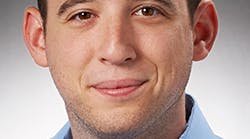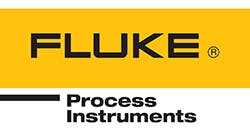How thermal imaging is driving value in the industry
Dylan Erwin is the Technical Sales Manager for Fluke Process Instruments and has previously worked as a product innovation manager and regional sales manager, among other responsibilities. Dylan received his BS in Mechanical Engineering from Montana State University and spent the first few years of his professional career in the industrial automation market. Dylan recently spoke with Thomas Wilk about the many uses of thermal imaging devices on the plant floor and the future of the technology, including the release of the TV40 Thermal Imager from Fluke Process Instruments.
PS: In the past pandemic year, we've noticed a renewed interest in thermal in general, however a survey from Plant Services indicates that infrared has been go-to as a technology for some time now with the majority of our readers. Could you talk about some of the applications where thermal imaging has traditionally been driving value in industry?
DE: Yeah, absolutely, and first of all, you're right. Thermal imaging technology has been around for quite some time now. I would assume that your audience is probably most familiar with the use of the hand-held thermal imagers to survey mechanical or electrical equipment, some kind of plant asset or a hotspot, where it might mean something is failing or about to fail. And really, you can find this kind of application in just about any industrial facility, from manufacturing to utilities. The technology is great, it's got that eye-catching visualization appeal, right, where you've had hand-held infrared thermometers or pyrometers, right, just non-contact temperature sensors that have probably been around even longer but really don't give that same ability to point the imager, see that temperature distribution, and really hone in on where that localized hotspot is.
So, while the handhelds are fantastic tools for that and provide very valuable information, they can only really provide that while they're being used. For that reason, we've seen this increased interest in the 24/7 continuous temperature monitoring, particularly in those areas that are most critical to plant operation either from a productivity or a safety perspective.
PS: We're seeing that interest grow also in general with 24/7 remote monitoring, including thermal. I've noticed that one of the less common applications for thermal is to help maintain product quality, and just in general plant productivity overall. Can you talk about what you're seeing in the field in this regard?
Dylan Erwin
DE: Temperature is often a key measurement related to quality. To provide some additional context and help explain the scope or the reach of some of these applications, in addition to fixed thermal imagers with process instruments as a broad portfolio, single point infrared non-contact temperature sensors, you know, pyrometers, and when I explain to friends or a new acquaintance kind of what I do, I'll tell them that we're part of processes manufacturing anything from tortilla chips to the chips in your smartphone. Fixed imagers have that similar reach, with providing value and manufacturing food, medical devices, transportation equipment, metals, building materials, the list goes on.
On the quality side, there are two main groups I'd put these applications in, the first being 100% quality inspection or pass-fail process control. As an example there, we've done a lot in automotive manufacturing for components, so if you picture the rear windshield on your car, right, it's got that defroster grid where you press a button and those lines heat up and keep it clear, make sure you have good visibility looking out the back. Those manufacturers will have each one of those rear windshields coming down the line, hit a test station, and we'll monitor it with a thermal imager to make sure that those elements are heating up, there's no breaks, that it's a continuous circuit and that there are no defects before it gets passed on to the assembly plant.
Another example within automotive, looking at either plastic components or housings for electronics or other pieces, right? There’s a lot of laser ultrasonic welding methods there, and the thermal imager gives you that full view not only of the welds, you can see that's a complete weld, but you're measuring the temperature along it. Too cold of a temperature might indicate that the weld didn't actually take place, you don't have a firm seal there, whereas going back to the ultrasonic example, if the two pieces are not pressed together hard enough, you don't have that thermal energy being dissipated, and it might be a weak weld at that point. Manufacturers ensuring that their products are to-specification before shipping them further down the supply chain or onto consumers is a pretty solid example there.
The other kind of bucket on the quality side I would say is just more general process monitoring to where you don't necessarily have a discrete part or product that you're ensuring is meeting all of those requirements, but where leading manufacturers are just collecting data for further research and analysis, trying to understand process changes or potentially even indirectly identifying equipment or maintenance issues. For example, if you have an aggregate product that's being heated or dried out in some sense, and you've got a thermal imager monitoring that belt as it's coming down the line or exiting your oven or your furnace, then a cold section of that belt's going to tell you, “oh, hey, maybe something's going on with a burner within the oven, we should go identify that before we start having more issues.” So, just, you know, a few examples there on the quality side.
I think on the productivity side, I've already touched on some of those critical assets or those pieces of equipment that are most important for plant operation. An example there, in a steel manufacturing facility and of which there are all kinds, in many of them, there's what we call a ladle, quite different than what you typically think of a ladle for pouring out soup. This ladle is a massive refractory brick-lined vessel that's transporting molten steel from the furnace to the next part of the process, however it's being formed. Oftentimes, there will be multiple of those ladles that are just in constant operation, and by having some fixed thermal imagers set up to where you can inspect each one as it goes through each cycle, you're identifying any of that refractory that's potentially wearing out, indicated by a hotspot and being able to alarm on that. If that brick does fail and you do have a potential blowout, it's a huge productivity concern and a safety concern as well if you're starting to leak molten steel.
Listen to the entire interview
Another example on the critical asset side, in a cement plant, in a paper plant where you've got a lime kiln, these massive rotary kilns, some of the biggest pieces of industrial machinery that are out there, again, similar story, you have the steel shell that's insulated with refractory brick where this thermal processing is happening. These are of the scale where if you have a failure on that brick and you end up burning a hole through your shell, not only do you have a significant downtime concern where these things are running 24/7 and oftentimes, you can't afford to have it down that long, but then, you also happen to deal with extra costs and trying to expedite the repair of that which is something that could have been prevented just by saying, “hey, we need to replace these bricks on our next downtime.”
PS: We're seeing a lot of end-users bundling thermal into other datasets, like you said, like ultrasound, sometimes motion capture videography, but also often just on its own, as its own condition monitoring dataset. When it comes to thermal imagers, I wanted to ask you about the Fluke Process Instruments TV40 Thermal Imager specifically. What sets that particular imager apart from other thermal cameras in the market?
DE: The value from the TV40 comes not just from the camera itself, but from the entire solution that you have available. So for example, we've got a number of accessories that allow it to operate in harsh industrial environments, networking equipment to get it connected into your control system or computers back in the control room, and there's some field-interchangeable lenses that can either expand or focus in that field of view, what you're really monitoring. In addition, there’s a built-in standard camera for a simultaneous infrared invisible feed, we've seen some customers that have seen a lot of value in that; a pan and tilt mechanism, which is a device that allows you to mount the camera and really optimize your coverage, you can point it in pretty much a 360° arc up, down, and really survey a site. There are a lot of additional components that allow us to tailor the best system solution for just about any applications.
The real differentiator with all of that is the ThermoView software that ties everything together. The software has some very powerful automation capabilities – I could go on all day about those – but, for example, automatic alarms, signaling, data recording, being able to send an email with an infrared picture attached automatically. All of that can be combined with some basic and/or logic to also take in an input from a customer's control system, you know, a trigger to drive something or just work based on some kind of timing condition. There's a lot there, and it can be very deep and complicated, these programs you can come up with, and that said, it's still pretty intuitive to use. For example, we were at one of our Fluke sites the other week collecting some photos and videos for marketing purposes, and one of our marketing managers with zero hands-on experience with the product was able to get the camera set up, software running, connected, streaming just within a couple of minutes. So, it's pretty straightforward to go and do that.
And on my side, I'm not a controls or an automation engineer by any means, but I've been able personally to go to customer sites and work with them to set up programs. I used the pass-fail control example previously, but well, we're setting up a bunch of areas of interest, we're setting these temperature conditions to make sure that these elements get heated up to a certain range, we're combining that with a trigger from their PLC, and then turning it back out as either a pass or a fail signal to then drive that automated action. So, that's where we've seen a lot of the value: customers are able to set up some pretty sophisticated 24/7 monitoring and automation programs without having to rely on a third party for integration or any kind of custom software programming.
PS: That's really good and it's critical to have something which is easy to start up and implement like that without the necessary support of an integrated partner to get that going.
DE: Yeah. And the last thing I'd say that, you know, I've got to give a shout out to our applications and technical support team that's always ready to help set up and troubleshoot either remotely or on-site. They do a great job.
PS: That's awesome. There always seems to be some sort of innovation coming down the pipeline for thermal every couple of months. What kind of advances do you see coming down the pipeline over the next five years that you can share with our listeners?
DE: First, I'd like to look kind of at the last five years and see where we've come. The cameras themselves have definitely improved, with higher pixel resolution, and faster streaming rates. In addition to that, we've got more flexible communication and integration options, some standalone functionality that's worked its way in as well, and we'll definitely continue to see more of that I think in parallel with general technology trends, like smaller form factors, and better performance. I don't want to say we're kind of at this wall from the measurement or the visualization perspective, i.e. the ability of the camera to see and measure, but we're getting a lot of data. For the TV40, that's 640 by 480-pixel resolution streaming at up to 60 frames per second. That's over 18 million discrete temperature measurements per second.
That’s some of the marketing spin we like to put on it, but I'll usually turn around and say it's overkill at that point. What really matters is being able to select the right data, and then do something with it. So, there will be more emphasis on facilitating and streamlining corrective action based on that temperature data that matters, and a lot of that's enabled through simpler integration, increasing that interoperability with different control systems and communication protocols, having remote access for unmanned sites, and not even necessarily just a remote site out there. If you've got a pan and tilt system that's monitoring a substation, you might just be in the plant and want to see what's going on with our process down at the other end of the facility without having to walk all the way over there. So, really just enabling that instant access to data wherever you are.
I think as awareness continues to increase in this, we've seen some interest driven by insurance and kind of regulatory perspectives as well, more with safety in mind. You can think of fire prevention and detection (we don't market these as fire alarms, they're not meant for that) but with some of the features that are in there, they do have the ability to see heat building up before you might have a potential fire, in either coal or biomass pile monitoring, for example.
As far as some of the neat stuff we'll start a little bit further, probably in the not too distant future, is the integration of AI tools. It's a bit hard to say exactly what this might look like, but more intelligent software, whether it's intuitive setup of areas of interest, if you're manufacturing a part and you've already got your automation program configured for it, and now you're going to start manufacturing a new part. Maybe it's a copy-paste, and then software that's saying, “hey, we notice that you're doing some things a little bit different here, let us take a stab at trying to sort this out for you.” It could be defect detection within the actual image: you may have your areas of interest set up based on set parameters, but if it happens to notice a cold spot or some other kind of anomalous temperature event somewhere else, that could be a great tool.
It might even just be, we hear this term, the industrial Internet of Things, Industry 4.0, right, this integration of multiple data streams to where this thermal analysis offer could say, “hey, we know that it's going to be a little bit colder outside for the next few weeks, maybe you should adjust your furnace temperatures accordingly to make sure there's no variation on the final product.” So, there's a lot of stuff on that front that I think is going to be exciting to see how it really develops and comes into industry.


